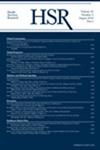The impacts of New York's balance billing regulation on ground ambulance pricing
Abstract
Objective
To examine the effects of New York's surprise billing regulations on price changes by emergency ground ambulance service providers.
Study Design
We exploited a natural experiment using a difference-in-differences design with randomization inference (RI) to examine the effects of New York state regulations on the prices of emergency ground ambulances, analyzing 2012–2019 commercial claims data. In March 2015, New York implemented a law protecting patients from surprise out-of-network (OON) balance bills, including ground ambulance services. New York's policy tied OON ground ambulance reimbursements to usual, customary, and reasonable rates that typically reflect charges. The control group consisted of similar states that never enacted surprise billing laws. Although self-funded plans are exempted from state laws, we also examined for spillover effects on self-funded plans.
Data Source and Analytic Sample
Multi-payer national commercial plan claims data were used. The study sample was selected by isolating claims involving an emergency ground ambulance activation code.
Principal Findings
The event study findings indicated that New York's law led to a continuous increase in prices, relative to controls. The law's implementation was associated with an overall emergency ground ambulance price increase of 13 percentage points (RI p-value: 0.07). We observed a 21-percentage-point increase in in-network prices (RI p-value: 0.07) and a 19-percentage-point increase in OON prices (RI p-value: 0.07), relative to controls, for fully insured health plans. Similar changes in overall prices and in in-network prices were observed in self-insured plans. Last, our study did not find statistically significant evidence of changes in out-of-pocket cost-sharing amounts under New York's regulation.
Conclusions
Balance billing laws based on charges can lead to price increases for emergency ground ambulance services. Legislation intended to inoculate patients from these surprise billings for ground ambulance transportation may have unintended consequences for costs of care.
What is known on this topic
- Emergency ground ambulances are a major source of surprise billing.
- The federal No Surprises Act of 2020 excluded emergency ground ambulance services.
- Some states have regulations that prohibit out-of-network balance bills for ground ambulance services.
What this study adds
- The study provides the first empirical evidence on the potential impacts of regulations on price changes among emergency ground ambulance providers.
- The study offers evidence of state policies' effects on fully insured plans and potential spillover effects on self-funded plans.
- Experiences from New York's state ambulance out-of-network billing regulation indicate that tying reimbursement policies to charges may have the unintended consequences of increasing health care costs.


 求助内容:
求助内容: 应助结果提醒方式:
应助结果提醒方式:


